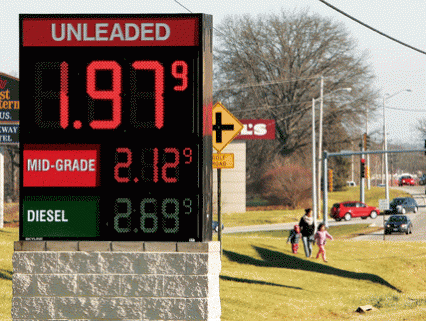
Gasoline price drops below two dollars per gallon, December 2014.
Consumers have received a huge “tax cut” in the form of lower gasoline prices, as the price of oil has fallen steeply over the last seven months, to its lowest point since May 2009. From a mid-2014 price of $115 per barrel, oil has plunged more than 40 percent, translating into a national average price at the pump for gasoline nearing $2 a gallon. The dramatic decline is due mostly to classic fundamentals of supply and demand, according to most analysts. There are some “conspiracy theories,” however—is Saudi Arabian attempting to crush the U.S. shale-oil industry? Are the Americans and Saudis in collusion to bankrupt Russia and Iran?
Owing largely to the surge in oil production in North America, the world’s supply has grown steadily, even as global demand lags behind forecasts. Also on the supply side, producers worldwide have not slowed production; for example, in early December the Organization of Petroleum Exporting Countries (OPEC) announced it would not lower its production targets. The result has been an oil glut. The main reason for slack demand is slow overall economic growth in many developed economies. Emerging-market economies like China and India continue to grow, and their demand for oil continues rising—though less than expected.
The falling oil price is a problem for countries that are heavily dependent on oil exports, such as Russia, Iran, and Venezuela, but for most consumers and many businesses it is a windfall. The Energy Information Administration estimates that in 2015 the average family in the United States will save $750 thanks to lower gasoline costs. For many companies, a lower oil price also should mean reduced input costs, such as for transportation or for oil-based materials, which will help their bottom line. Such savings can then ripple through the economy, pushing down prices of other goods and services. The downside for the U.S. oil industry is that, at lower prices, production based on higher-cost extraction methods may slow, or in some instances stop altogether. Production of “unconventional oil” such as that extracted from shale formations, is profitable only when the price of oil remains above a certain level.
Image credit: © AP Photo/The Telegraph, John Badman
Related Links
- Why the Oil Price Is Falling
This story focuses on the causes of the oil price fall, including the “conspiracy theories” based on geopolitical speculations.
(Source: The Economist, December 8, 2014) - Oil Price Drops: Don’t Panic, Really
This article examines the oil and gas industry, especially how lower prices in the short run will force producers to reduce costs in the long run.
(Source: Fortune Magazine, December 8, 2014) - Falling Oil Prices: Who Are the Winners and Losers?
This article attempts to identify who benefits and who is harmed by lower oil prices.
(Source: BBC News, January 7, 2015) - Drilling Down—Understanding Oil Prices and Their Economic Impact
This careful explanation of the recent drop in oil prices, by a Canadian central bank official, provides historical background, global economic perspective, and a lesson in supply and demand—complete with a “hog cycle” analogy; pdf version includes more than a dozen graphs.
(Source: Bank of Canada, January 13, 2015) - Gasoline Demand Rising as U.S. Drivers to Save $750
This article includes oil price and demand forecasts from the Energy Information Administration.
(Source: Bloomberg.com, January 13, 2015)




this is the best time ever
ight
nah